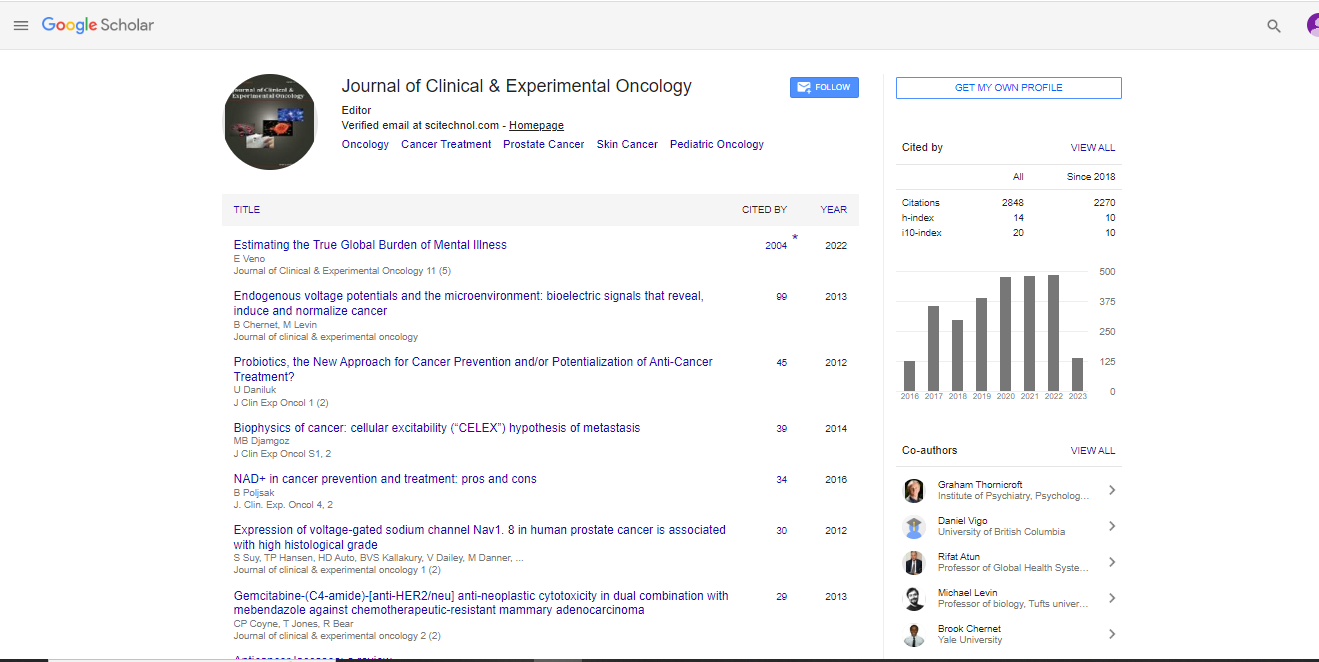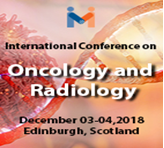Commentary, J Clin Exp Oncol Vol: 13 Issue: 6
Significance of Pediatric Oncology in Childhood Cancer Survival
Semeric Tanisen*
1Department of Child Health and Diseases, Karadeniz Technical University, Trabzon,
Turkey
*Corresponding Author: Semeric Tanisen,
Department of Child Health and Diseases, Karadeniz Technical University, Trabzon, Turkey
E-mail: semerictan@ktu11.tr
Received date: 27 November, 2024, Manuscript No. JCEOG-24-156856;
Editor assigned date: 29 November, 2024, PreQC No. JCEOG-24-156856 (PQ);
Reviewed date: 13 December, 2024, QC No. JCEOG-24-156856;
Revised date: 20 December, 2024, Manuscript No. JCEOG-24-156856 (R);
Published date: 27 December, 2024, DOI: 10.4172/2324-9110.1000446.
Citation: Tanisen S (2024) Significance of Pediatric Oncology in Childhood Cancer Survival. J Clin Exp Oncol 13:6.
Keywords: Department of Child Health and Diseases, Karadeniz Technical University, Trabzon, Turkey
Description
Non-melanoma Skin Cancers (NMSCs) are the most common forms of skin cancer globally, affecting millions of people each year. Unlike melanoma, which is known for its severity and potential to metastasize, NMSCs generally grow more slowly and are less likely to spread. However, their prevalence is high and they can cause significant health issues, especially if not diagnosed and treated early. The two primary types of NMSC are Basal Cell Carcinoma (BCC) and Squamous Cell Carcinoma (SCC) both of which primarily arise from exposure to Ultraviolet (UV) radiation. The incidence of nonmelanoma skin cancers has been steadily rising worldwide, particularly in regions with high levels of sunlight exposure. In the United States alone, over 5 million cases of BCC and SCC are diagnosed each year, making these the most commonly diagnosed cancers. NMSC is especially common among fair-skinned individuals, who are more susceptible to UV radiation and in older adults, as cumulative sun exposure over the years increases risk.
BCC is the most prevalent form of skin cancer, accounting for about 80% of NMSC cases. It originates in the basal cells, which are located in the outermost layer of the skin and usually appears as a small, shiny bump or a patch of skin that looks pearly or translucent. Although BCC rarely spreads to other parts of the body, it can invade surrounding tissues and cause deformation if not treated. SCC on the other hand, constitutes roughly 20% of NMSC cases. It arises from the squamous cells, which are also found in the skin’s outer layer and commonly presents as a firm, red nodule or a scaly crusted patch. While SCC has a higher potential for spreading than BCC, it generally remains localized if caught early. However, advanced SCC can spread to lymph nodes and distant organs, making early detection is vital.
The primary risk factor for NMSC is UV radiation exposure, which can come from natural sunlight or artificial sources like tanning beds. UV radiation causes DNA damage in skin cells, leading to mutations that increase cancer risk. Regular, long-term exposure to UV radiation is one of the most significant risk factors for NMSC. Individuals who work outdoors or frequently engage in outdoor activities without sun protection are at an increased risk. Fair-skinned individuals with lightcolored eyes and hair have less melanin, a pigment that provides some protection against UV damage. As a result, they are more susceptible to skin cancer than individuals with darker skin tones. NMSC is more common in older adults due to cumulative sun exposure over the years. Men are also more likely to develop NMSC than women, likely due to differences in sun exposure and occupational hazards. Individuals who have had skin cancer before are at a higher risk of developing it again, especially if they continue to be exposed to UV radiation.
People with weakened immune systems, such as organ transplant recipients or those with certain medical conditions are more susceptible to NMSC because their bodies are less able to repair DNA damage caused by UV radiation. Exposure to certain chemicals, such as arsenic or coal tar can increase the risk of developing NMSC especially SCC. The treatment of NMSC depends on the type, size, location and stage of the cancer, as well as the patient’s overall health. In most cases, NMSC can be treated effectively, especially when detected early. Surgical excision is one of the most common treatments for NMSC. The procedure involves removing the tumor along with a margin of healthy tissue to ensure complete removal of cancer cells. It is often effective for both BCC and SCC and is especially recommended for tumors in low-risk areas. Mohs surgery is a precise surgical technique used to treat NMSC, particularly for tumors in cosmetically sensitive areas such as the face. During this procedure, thin layers of skin are removed and examined under a microscope until no cancer cells are detected. This approach minimizes the removal of healthy tissue and reduces scarring while ensuring a high cure rate.
Cryotherapy or freezing is commonly used for small, superficial NMSCs. Liquid nitrogen is applied to the cancer cells, freezing and killing them. This treatment is often effective for low-risk BCCs and SCCs and has a relatively quick recovery time. Radiation therapy is sometimes recommended for patients who cannot undergo surgery or when the cancer is located in a difficult to treat area. It involves targeting cancer cells with high-energy radiation to destroy them. Although effective, this treatment may require several sessions and has potential side effects including skin irritation. For certain cases of superficial BCC and SCC topical treatments like 5-Fluorouracil (5- FU) and imiquimod cream may be applied directly to the affected skin. These medications stimulate the immune system to attack the cancer cells. Topical treatments are typically used for small, earlystage cancers and are less invasive than other methods.
Conclusion
Non-melanoma skin cancers are highly prevalent, particularly among those with high UV exposure, fair skin and a history of prolonged sun exposure. While NMSCs are generally less aggressive than melanoma they can still cause significant health issues if left untreated. However, several effective treatment options are available, including surgical excision, Mohs surgery, cryotherapy and topical treatments. Early detection and preventive measures, such as avoiding excessive sun exposure and wearing protective clothing are essential in reducing the risk of developing NMSC. Public awareness campaigns promoting sun safety and regular skin examinations can help in identifying skin cancer early and ensuring timely treatment. With continued studies and improved treatment options, the chances for individuals with non-melanoma skin cancer remains positive.
 Spanish
Spanish  Chinese
Chinese  Russian
Russian  German
German  French
French  Japanese
Japanese  Portuguese
Portuguese  Hindi
Hindi 



